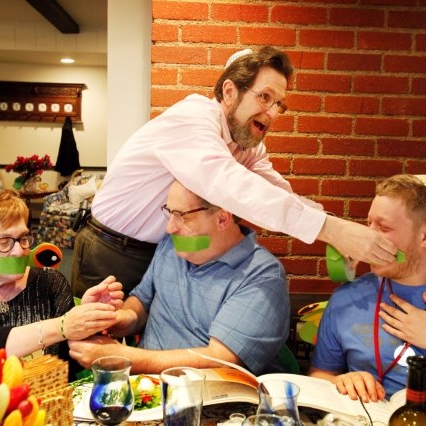
Religion

Ten easy tips to avoid a boring seder
RABBI REBECCA ROSENTHAL, NEW YORK
Designing a seder that can work for everyone can feel like a challenge for even the most seasoned educator, let alone a busy parent.
But there is magic in the seder. Having loved ones around a table together can feel like a luxury in this day and age, so here are some tips for making the most of the festive meal. I hope these ideas will inspire you to be creative in a way that feels authentic to your seder.
The seder’s purpose is to get people to ask questions, so the more you break the mould of the way you have always done it, the more likely you and your guests will be able to access the true meaning of the holiday.
10 TIPS TO PERK UP YOUR SEDER:
1. Put out some food earlier. Food is always important in Jewish events and never more so than in the seder. It can feel like a long time until you get to dinner, but after karpas (the green vegetable that comes right at the beginning), you can serve appetisers.
Vegetables and a dip or fruit are good healthy options, but my family also puts out candy, which keeps the kids busy for a little while. If you want to be thematic, there is fair-trade, slavery-free chocolate that is kosher for Passover.
2. Play with your food. Along the same theme, there are fun ways you can incorporate food into the heart of the seder. One friend of ours attaches the parsley to mini fishing rods and uses them to dip the parsley in the salt water.
Another friend chops up lots of fruits and nuts (and even some chocolate) and allows the guests to make their own charoset, as long as it resembles the mortar. When it comes time to remember the plague of hail, I have heard of families throwing mini marshmallows at one another.
Finally, there is a Persian custom of lightly (or not so lightly) slapping your neighbour with scallions during the song “Dayenu” as a reminder of slavery.
3. Use the table. Put something interesting on the table, either in the middle or at each individual plate. We have used different kinds of frogs, puppets and masks. Perhaps it will inspire a guest to ask a question about Passover, the story or the traditions of your family. At the very least it will entertain those at the table when they need a break.
4. Don’t be a slave to the Haggadah. The Haggadah is meant as a guide, and you don’t have to read every word to fulfil your obligation to tell the story. Get many different Haggadahs and look for readings and retellings that speak to you and share those at the seder. Or get the kids to write a play about the Passover story and perform it. Or ask your guests to bring something that represents freedom and tell the story of why.
As long as your guests are engaged in the story of slavery to freedom, you have done your job.
5. Move around. This is the story of a wandering people. If you have the space, then wander! Do one piece of the seder in the living room, one in the dining room, or even go outside if the weather permits it. Turn a few bed sheets into the sea and walk through it on your way to the Promised Land. Give your guests a chance to be in the story, not just talk about it.
6. Assign homework. People always do better if they are prepared, so ask your guests to participate in the seder. Send a question in advance, ask them to bring something or even make decorations for the seder table.
Guests, bring a reading or an object that speaks to you. I guarantee your host will appreciate not having to carry the weight of the entire evening.
7. Give everyone a job. Before the seder, make a list of everything that has to be done during the evening, from pouring the wine to serving the soup to clearing the table. Then, assign away. You guests will be happy to help, and you will be happier if you come out of the seder not feeling enslaved.
8. Sing (or watch videos). There are tons of songs for kids and adults alike for Passover. Google around to find tunes or songs that you like and teach them at your seder.
Providing song sheets helps everyone sing along. And if singing is not your thing, a quick search on YouTube for Passover song parodies turns up videos that would be fun to watch before or during the seder.
9. Make something. When I was about 10 years old, I spent hours creating a chart that outlined the order of the seder. I made a small arrow that could be used to show where we were in the progression of the evening, and since then it has been used every year.
My mother still brings out Elijah’s cups that my sisters and I made in Hebrew school, and my kids proudly show off their seder plates, kiddush cups and matzah covers. If your kids don’t make them in school or Hebrew school, these are easy crafts to make at home.
10. Let loose. The point of the seder is to engage people in the questions, both ancient and contemporary, of slavery and freedom. The way you do that is up to you.
Try to find a balance between preparing for the seder and obsessing about every detail. And if your kids run screaming circles around the table while everyone else is trying to talk, as mine have done on more than one occasion, those are memories, too. Don’t beat yourself up about it. (Kveller via JTA)
Rabbi Rebecca Rosenthal is the director of youth and family education at Central Synagogue in New York City.




